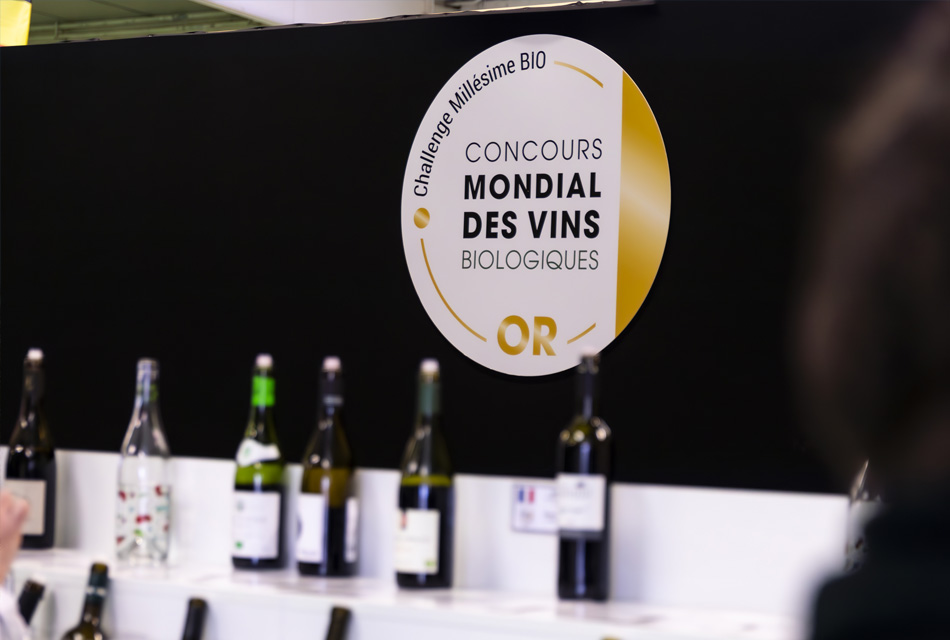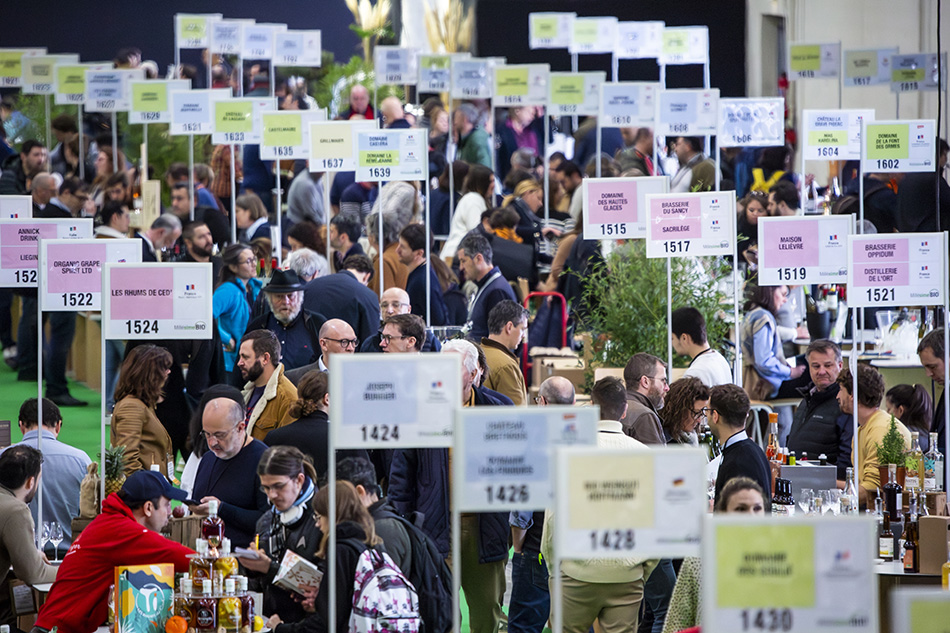
The 2025 edition of Millésime BIO wrapped up at the end of January.
What are your takeaways from this 32nd edition?
Muriel: This 32nd edition brought together 1,500 exhibitors from 16 countries and recorded 9,500 visits, 80% of which were from French buyers and market players, and 20% from international visitors. The presence of a highly qualified audience—including wine merchants, sommeliers, wholesalers, importers, and specialized buyers from around 50 countries worldwide—offered reassurance about the dynamism of international demand, especially for French exhibitors focused on export markets.
This edition also came with a number of challenges, including purchasing power tensions and geopolitical uncertainties. Yet, despite a somewhat tense wine market both domestically and internationally, the show conveyed strong momentum, a testament to its appeal among international buyers.
Olivier, you spearheaded the introduction of uniform booth furniture for all exhibitors.
What motivated that decision?
Olivier: Since the show’s inception 32 years ago, all exhibitors have had the same stand setup, regardless of their status. But previously, this meant simple skirted tables, which did little to highlight the products or encourage meaningful interaction between exhibitors and visitors.
In 2020, the association made a major investment in high-quality, French-made wooden furniture—high counters, stools, and custom signage. This setup not only provides greater comfort for tastings but also offers a more polished showcase for bottles. It has enhanced the “premium” feel of the show. All exhibitors benefit from the same display materials, regardless of their budget, and this is unique among major professional trade shows. It reflects the DNA of Millésime BIO—a show by winemakers, for winemakers.

You’ve also developed the “other organic alcoholic beverages”
section and launched a digital edition
Muriel: Since 2019, we’ve created a dedicated space for other organic alcoholic beverages—including beer, cider, and spirits. The goal is to offer visiting buyers a comprehensive product range so they can source all their organic alcohols in one place, in line with the expectations of their end consumers, particularly younger ones. This is especially relevant for wine merchants, restaurants, and wine bars.
The drop in purchasing power has particularly affected organic products,
often perceived as more expensive. What steps are being taken to make
organic wines more attractive?
Olivier: The current climate is tough for wine in general—not just organic wine. We’ve seen a decline in alcohol consumption over the past 2–3 years. The economic crisis driven by geopolitical instability has taken a toll on organic products, with consumers leaning toward cheaper, more basic options. Paradoxically, key indicators for the organic wine sector remain relatively encouraging: overall revenue increased in 2023 (based on the latest data). Organic wine sales rose by 6% in volume that year, although this masks some disparities—sales through direct-to-consumer channels and wine merchants are on the rise, while large-scale retail continues to struggle. One in ten bottles sold in France is now organic. The organic products sector in specialized stores has been on the rebound since 2024—hopefully organic wine will follow suit.
As for price, just like conventional wines, organic wines are available across a wide range—from entry-level to premium. It’s important to remember that production costs (especially labor) are higher in organic farming because winegrowers spend more time in the vineyard. But these costs are just one part of a wine’s price.
Many other factors come into play, such as the winemaker’s reputation or winemaking methods. Drinking an organic wine free from synthetic treatments also adds value that can’t be directly reflected in the selling price. Organic winemakers also tend to adopt more modest approaches to packaging and marketing, helping them offset costs and offer wines at reasonable prices. The attractiveness of organic wine hinges on communication with consumers. We must educate them on the benefits of this type of farming—for themselves, the producers, and the planet. To this end, we’ve launched a dedicated website to inform and answer questions from anyone interested in responsible consumption.

Occitanie accounts for 35% of France’s organic vineyards.
What explains this strong regional presence?
Olivier: Occitanie is France’s largest wine-producing region, with 33% of the country’s vineyards, 51 Protected Designations of Origin (PDOs), and 36 Protected Geographical Indications (PGIs). With 58,808 hectares of vineyards under organic farming in 2023, Occitanie is naturally France’s leading organic wine region. Several factors explain this: a warm, dry climate that limits fungal disease development, and strong environmental commitment from local winegrowers, many of whom have been pioneers. Some of their plots have never been exposed to chemical treatments!
Occitanie has long been a hub of the organic movement in France. As early as the 1970s and 1980s, local winemakers were among the first to return to the principles of organic agriculture and advocate for the creation of the AB label. SudVinBio—an interprofessional association promoting and defending organic winegrowers in Occitanie—was founded in 1991, just a few years after the AB label was launched in 1985, which celebrates its 40th anniversary this year.
Interview by Sandy Bénard-Ravoisier
Photos: MINDPROD